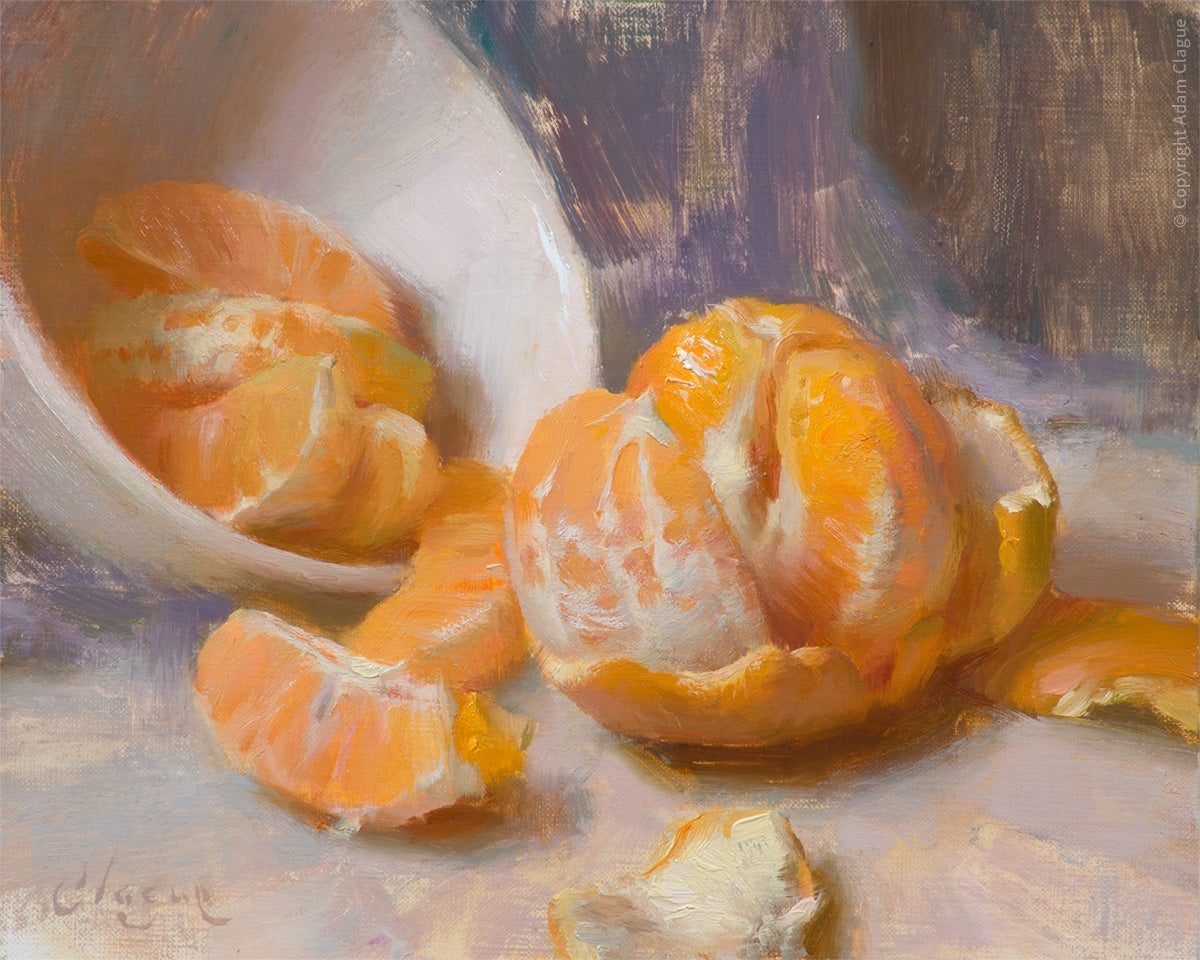There are moments that seem too small to remember. The way light slants through a window at 2pm. The sound of an orange peel tearing. The ritual of a spoon in a bowl. Most days, I pass through these moments blindly, chasing deadlines, distracted by noise, numbed by habit. But I’ve come to believe—perhaps against the grain of modern life—that the ordinary is not beneath us. It’s simply quieter than we are.
What I want, more than certainty or spectacle, is attentiveness. Not the kind of vigilance born of anxiety, but the kind born of reverence. I want to live a life that notices.
And sometimes that begins with something as small as an orange.
Adam Clague’s painting Halves & Segments first caught my eye not because it was bold, but because it was still. A white bowl tipped gently. An orange peeled, resting. Segments glisten in the soft light—flesh exposed, not devoured. There is no extravagance here. Only patience. Only presence.
Clague’s brushwork is reverent. His attention, palpable. He does not over-render; he suggests. He trusts the viewer to meet the fruit halfway. And in doing so, the orange becomes something more than fruit. It becomes a gesture. An offering. A moment suspended in paint.
Looking at it, I thought: This is what attention looks like when no one is watching.
I thought, too, of St. Gregory’s Abbey.
Years ago, I spent time with the monks there—joining them in their rhythms, their meals, their silence. We did not take vows of silence; we simply practiced it. Three meals a day, eaten together in quiet. The scrape of forks. The rustle of napkins. Sometimes, a Psalm. Always, after a few minutes, a voice.
One of the monks would rise, walk to the lectern, and read aloud from the chosen book. It might be Augustine, or Bonhoeffer, or the diary of a missionary long since buried. Whatever the text, it was read slowly, without commentary, folded into the meal like a second nourishment.
We listened while we ate. No response, no debate. Just chewing and listening—body and soul receiving at the same pace.
I didn’t realize at the time how rare this was: a meal without hurry, without screens, without distraction. And how much of life I was consuming without tasting.
To eat an orange well is to live differently.
It begins with the pause. The choosing. The weight in your palm. You must break the skin, slowly. Let it open. Feel the spray of oil as the rind gives way. Smell the sharp brightness. Peel it segment by segment. Do not rush. Let the juice linger on your tongue. Let it interrupt you.
In this way, eating becomes something more than intake. It becomes a form of devotion. A quiet rebellion against speed and noise.
Camus might have called it absurd—this finding of meaning in repetition. But I think he would have understood. In The Myth of Sisyphus, he tells us that even in the face of meaninglessness, we can choose to embrace life. We must imagine Sisyphus happy, he writes—not because his task is noble, but because he gives himself fully to it.
To eat an orange with care is to take up our own little stone and say: This is enough. This sweetness is enough. This life is enough.
Clague’s painting is not just a still life—it is a stillness made visible. A lesson in form, color, texture. But more than that, it’s a lesson in attention. And in my better moments, I try to live this way. Not chasing transcendence, but noticing it where it already is—in the kitchen, the bowl, the fruit, the voice that reads while we chew.
Simone Weil said that attention, taken to its highest degree, is the same as prayer. That’s what the monks were practicing, whether washing dishes or reading at dinner. That’s what Clague is practicing, too—one brushstroke at a time.
And maybe that’s what I’m practicing when I slow down enough to write these reflections. When I let the day be more than a blur. When I remember how the light looked this morning. When I eat an orange slowly.
What if nothing needs to be extraordinary to be sacred?
What if we’re simply moving too fast to see the glow? What if intention—not ambition—is what transforms the moment?
I return again to Halves & Segments. I look at that quiet little fruit and feel something inside me soften. I imagine a table. A peeled orange. A book being read aloud. I imagine time slowing down—not for the sake of productivity, but for the sake of presence.
